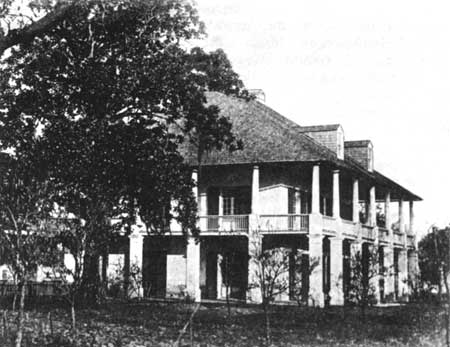|
CHALMETTE National Historical Park |
 |

This is from an old photograph of the now
destroyed plantation home of Augustin Francois Macarty, used by Andrew
Jackson as his field headquarters.
From the collection of
Stanley Clisby Arthur.
The "Grand Reconnaissance"
As soon as the mist cleared next morning, December 28th, Pakenham sent his troops forward in close-packed ranks across the cane stubble. The Britishers marched in two main columns, one near the river and the other on the edge of the cypress swamp. Skirmishers were deployed between the two columns. A British subaltern later wrote of the approach:
On we went for about three miles, without any let or hindrance from man or inanimate nature coming our way. But all at once a spectacle was presented to us, such indeed as we ought to have looked for, but such as manifestly took our leaders by surprise. The enemy's army be came visible. It was posted in rear of a canal, and covered, though most imperfectly, by an unfinished breastwork.
The artillery of the British fired at the unfinished mud wall and at the Louisiana. The Americans returned the fire, and in the artillery duel the British cannon were silenced. Then missiles from the ship and from American artillery on land broke up the attacking column along the river.
At the swamp end of the line, a detachment of Carroll's troops under Colonel Hutchinson was ordered to skirt the edge of the swamp and dislodge the invaders. When the colonel was killed by the first British fire, the detachment withdraw in confusion.
The British column along the swamp advanced toward the left of the American line, which was not as strong as the right. On seeing his other column broken, however, Pakenham ordered all his forces back. His officers were bitter at the thought that they could have turned the American left if permitted to continue the attack. Said the subaltern quoted earlier: "There was not a man among us who failed to experience shame and indignation."
This second land battle for New Orleans, called by the British a "reconnaissance in force," did not last long. The Americans lost 7 killed and 10 wounded. British losses were 9 killed and 8 wounded.

|
|
Last Modified: Mon, Dec 2 2002 10:00:00 am PDT |


